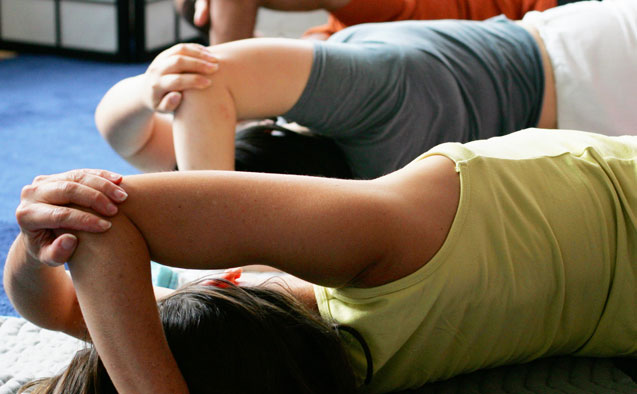THE FELDENKRAIS METHOD OF FUNCTIONAL INTEGRATION
The Feldenkrais Method aims at improving our functioning not only in the physical arena, but in all areas of our life. The method is based on scientific principles of physics, biomechanics, learning—– and human development. Whereas in other modalities, such as massage and chiropractic, the practitioner works directly with muscles and bones to affect changes through the individual’s structure, the Feldenkrais Method works instead with our ability to coordinate and regulate our movement. It works with the nervous system, so that we can improve our use of ourselves, regardless of any structural considerations we might have.
Anyone can benefit from the Feldenkrais Method
Those experiencing chronic or acute pain of the back, neck, shoulder, hip, legs or knee, as well as those who are healthy but wish to enhance their functioning. The Feldenkrais Method is also helpful in dealing with central nervous system conditions such as multiple sclerosis, cerebral palsy, and stroke. Performing Art professionals, such as musicians, actors and artists use it to improve their abilities and enhance creativity. Seniors benefit from it by using it to retain or regain the ability to move with ease and comfort, and improve balance.

FUNCTIONAL MANUAL THERAPY
Functional Manual Therapy (FMT) is an integrated evaluation and treatment system that promotes optimum human performance by enhancing total body mobility and CoreFirst postural and movement strategies. It brings a unique and comprehensive approach to patient care. Recent research and functional imaging of the brain continues to reveal the interrelationship between pain, muscular inhibition and poor movement strategies. Just mobilizing joints, giving patients stretching and strengthening exercises, or having a patient participate in “core stabilization” is not sufficient to address the complex interrelationship between the available mobility of the human system and the integration of automatic and volitional motor strategies. The unique aspect of FMT is the integration of the mobility treatment with neuromuscular facilitation (ability to initiate the right muscles at the right time with proper strength and endurance) and motor control (the ability to effectively produce coordinated postural and movement strategies).
The Functional Manual Therapist:
Is trained to identify specific mobility limitations within the joints, soft tissues, viscera and neurovascular tissues. Limited mobility in these structures can impair a patient’s function and ability to automatically and efficiently control our activities of daily living. The ultimate goal of Functional Manual Therapy is to provide the patient with the mechanical ability and the neuromuscular tools of strength and endurance and proprioceptive awareness to become self sufficient and more proficient in all areas of human performance.
